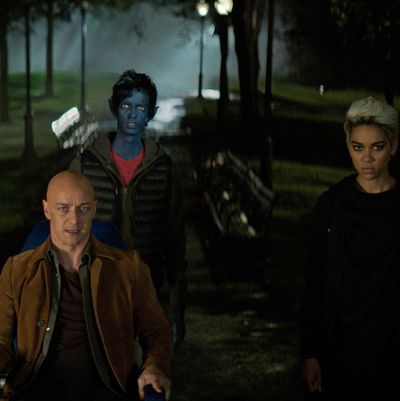
If, as seems likely, Dark Phoenix marks the end of the X-Men’s current onscreen run, the franchise is going out with a superpowered whimper, a $200 million nothing of a movie with all the emotional heft of a term paper scribbled overnight. When it comes to goodbyes, it’s less a grand farewell than an Irish exit. Everyone involved seems in a hurry to forget about the experience as soon as possible.
But before this movie disappears from the public consciousness, I want to take a few minutes to spotlight its most delightful moment of ludicrousness. These latter-day X-films have always been good for a few absolutely bizarre sequences — never forget the feature-length makeover montage that was X-Men: Apocalypse — and one midway through Dark Phoenix, which is inexplicably set in 1992, had me chuckling all the way home. It’s a lengthy action scene of the X-Men trying, and mostly failing, to cross the street.
Some context: After a run-in with a mysterious cosmic blob, Jean Grey (Sophie Turner) finds her powers spiralling out of control, with unfortunate results for one X-person (though perhaps not so unfortunate for the actor playing them, who has seemed done with these movies for a while). Jean flees into the arms of a baddie played by Jessica Chastain, who turns out to be the leader of a vagabond race of shape-shifting aliens who want to harness the powers of the cosmic blob for themselves. (Dark Phoenix reportedly reshot its climax to avoid duplicating Captain Marvel’s; fully purging this movie of every joyless similarity between the two films would have required the indefatigability of Marie Kondo.) Jean and Chastain — her character has a name, but considering it might have been added in post, it’s probably not worth making room in your brain for — hightail it to the aliens’ HQ, a swanky Upper West Side mansion, where the stage is set for a showdown: Half the mutants, led by Magneto (Michael Fassbender), show up to get revenge; the other half, led by Charles Xavier (James McAvoy), show up to stop them, convinced Jean can still be saved. What follows is a frenetic three-way battle: clean-cut hero mutants vs. grizzled antihero mutants vs. the vicious forces of New York City traffic.
In the movie’s most period-accurate detail, none of the mutants take the subway. Instead, both sides convene in Central Park, where they face their toughest opponent yet: Central Park West. Try as they might, they just can’t get across! Every time it seems like one of the heroes will almost make it over to the other side, a task many regular people are able to pull off multiple times a day, something gets in their way. Sometimes a car, other times a laser beam. It’s like the world’s hardest level of Frogger, if the frog had been blessed with unfathomable strength but still had trouble crossing a four-lane road. A wealthy New Yorker hasn’t had this much difficulty trying to perform an everyday task since Liza Minnelli tried to turn off that lamp:
In their defense, it’s not just regular rush-hour gridlock they’re fighting, it’s also each other. But as usual in a franchise whose fight choreographer’s favorite move is “Eh, just stand around” and whose art directors seem primarily inspired by Celeste Ng, even the comic-book fisticuffs lack punch. Twelve movies in, we’ve used up most of the good powers: Magneto’s team now includes Selene, a character who is apparently a “psychic vampire” in the comics but here just kind of holds a knife, and Red Lotus, a burly mutant who uses superpowered dreadlocks as weapons — more proof that, when it comes to henchmen, Magneto evinces very singular taste.
Eventually the whole thing comes to a climax when Magneto, a character who in the movie’s second-most-farcical scene loses a mental tug-of-war with Jean Grey over a helicopter, decides to heal his wounded pride by raising an entire subway train from underground so that he can use it as a battering ram to finally get in the got-dang house. Why use a subway train when the street, as we have seen, is chock-full of cars and buses that seem more than capable of doing the job? Maybe this speaks to an element of size anxiety on the part of Magneto, a onetime master of the universe who has been reduced to seasteading on a remote island community. Or maybe he’s always thought the A train should have more stops between 59th and 125th? The answer shall remain a mystery. But I do know why none of the X-Men just waited for the “walk” signal. In a franchise this exhausted, the last thing anyone wants is one more green light.


